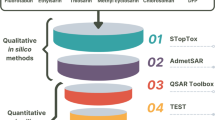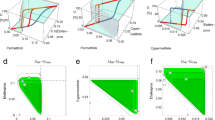Abstract
The concept of multiple modes of toxic action denotes that an individual chemical can induce two or more toxic effects within the same series of concentrations, for example, reactive toxicity and narcosis. It appears that such toxicity confounds the ability to develop precise predictions of mixture toxicity and makes it more difficult to clearly link a dose-additive combined effect to agents in the mixture having a single common mechanism of toxic action. This initial study of a three-part series begins to examine this issue in greater detail by testing three α-halogenated acetonitriles: (1) in sham combinations, (2) in true combinations, and (3) with a nonreactive nonpolar narcotic. Iodo-, bromo-, and chloro-derivatives of acetonitrile were selected for testing based on their electro(nucleo)philic reactivity, via the SN2 mechanism, and their time-dependent toxicity individually. Reactivity of each agent was assessed in tests with the model nucleophile glutathione (GSH). Each acetonitrile was reactive with GSH, but the nonpolar narcotic 3-methyl-2-butanone was not. In addition, toxicity of the agents alone and in mixtures was assessed using the Microtox® acute toxicity test at three time points: 15, 30, and 45 min of exposure. Each of the three agents alone had time-dependent toxicity values of about 100%, making it likely that most of the toxicity of these agents, at these times, was due to reactivity. In contrast, the nonpolar narcotic agent lacked time-dependent toxicity. In mixture testing, sham combinations of each acetonitrile showed a combined effect consistent with predicted effects for dose-addition at each time point, as did the sham combination of the nonpolar narcotic. Mixture toxicity results for true acetonitrile combinations were also consistent with dose-addition, but the acetonitrile–nonpolar narcotic combinations were generally not consistent with either the dose-addition or independence models of combined effect. Based on current understanding of mixture toxicity, these results were expected and provide a foundation for the second and third studies in the series.



Similar content being viewed by others
References
Bliss CI (1939) The toxicity of poisons applied jointly. Ann Appl Biol 26:585–615
Borgert CJ, Quill TF, McCarty LS, Wilson AM (2004) Can mode of action predict mixture toxicity for risk assessment? Toxicol Appl Pharmacol 201:85–96
Broderius SJ, Kahl MD (1985) Acute toxicity of organic chemical mixtures to the fathead minnow. Aquat Toxicol 6:307–322
Broderius SJ, Kahl MD, Hoglund MD (1995) Use of joint toxic response to define the primary mode of toxic action for diverse industrial organic chemicals. Environ Toxicol Chem 14:1591–1605
Calabrese EJ (1991) Multiple chemical interactions. Lewis, Chelsea, MI
Chen JJ, Chen Y-J, Rice G, Teuscher LK, Hamernick K, Protzel A, Kodell R (2001) Using dose addition to estimate the cumulative risks from exposures to multiple chemicals. Regul Pharmacol Toxicol 34:35–41
Dawson DA, Cotter MA, Policz DL, Stoffer DA, Nichols JP, Pöch G (2000) Comparative evaluation of the combined osteolathyritic effects of two nitrile combinations on Xenopus embryos. Toxicology 147:193–207
Dawson DA, Rinaldi AC, Pöch G (2002) Biochemical and toxicological evaluation of agent-cofactor reactivity as a mechanism of action for osteolathyrogens. Toxicology 177:267–284
Dawson DA, Scott BD, Ellenberger MJ, Pöch G, Rinaldi AC (2004) Evaluation of dose-response curve analysis in delineating shared or different molecular sites of action for osteolathyrogens. Environ Toxicol Pharmacol 16:13–23
Dawson DA, Pöch G, Schultz TW (2006) Chemical mixture toxicity testing with Vibrio fischeri: combined effects of binary mixtures for ten soft-electrophiles. Ecotox Environ Saf 65:171–180
Dawson DA, Allen JL, Schultz TW, Pöch G (2008) Time-dependence in mixture toxicity with soft- electrophiles: 2. Effects of relative reactivity level on time-dependent toxicity and combined effects for selected Michael acceptors. J Environ Sci Health A 43:43–52
Deneer JW, Sinnige TL, Seinen W, Hermens JLM (1988) The joint acute toxicity to Daphnia magna of industrial organic chemicals at low concentrations. Aquat Toxicol 12:33–38
Escher BI, Hermens JLM (2002) Modes of action in ecotoxicology: Their role in body burden, species sensitivity, QSARs, and mixture effects. Environ Sci Technol 36:4201–4217
Gagan EM, Hull MW, Schultz TW, Pöch G, Dawson DA (2007) Time dependence in mixture toxicity with soft electrophiles: 1. Combined effects of selected SN2 and SNAr-reactive agents with a nonpolar narcotic. Arch Environ Contam Toxicol 52:283–293
Hermens JLM, Canton H, Janssen P, de Jong R (1984) Quantitative structure-activity relationships and toxicity studies of mixtures of chemicals with anaesthetic potency: acute lethal and sublethal toxicity to Daphnia magna. Aquat Toxicol 5:143–154
Hermens JLM, Konemann H, Leeuwangh P, Musch A (1985) Quantitative structure-activity relationships in aquatic toxicity studies of chemicals and complex mixtures of chemicals. Environ Toxicol Chem 4:273–279
Hine J (1962) Physical organic chemistry, 2nd ed, International student edition. McGraw-Hill, New York, NY
Hodges G, Roberts DW, Marshall SJ, Dearden JC (2006) Defining the toxic mode of action of ester sulfonates using the joint toxicity of mixtures. Chemosphere 64:17–25
Jacobs A (1997) Understanding organic reaction mechanisms. University Press, Cambridge
McCarty LS, Mackay D (1993) Enhancing ecotoxicological modeling and assessment: body burdens and modes of toxic action. Environ Sci Technol 27:1719–1728
Plackett RL, Hewlett PS (1952) Quantal responses to mixtures of poisons. J R Stat Soc B 2:141–163
Pöch G (1993) Combined effects of drugs and toxic agents: modern evaluation in theory and practice. Springer-Verlag, Vienna
Pöch G, Dittrich P, Holzmann S (1990) Evaluation of combination effects in dose-response studies by statistical comparison with additive and independent interactions. J Pharmacol Meth 24:311–325
Pöch G, Dawson DA, Reiffenstein RJ (1996) Model usage in evaluation of combined effects of toxicants. Toxicol Ecotoxicol News 3:51–59
Rand GM, Wells PG, McCarty LS (1995) Introduction to aquatic toxicology. In: Rand GM (ed) Fundamentals of aquatic toxicology: effects, environmental fate and risk assessment, 2nd edn. CRC, Boca Raton, FL, pp 3–67
Roberts DW, Costello JF (2003) Mechanisms of action for non-polar and polar narcosis: a difference in dimension. QSAR Combinat Sci 22:226–233
Roberts DW, Aptula AO, Patlewicz G (2007) Electrophilic chemistry related to skin sensitization. Reaction mechanistic applicability domain classification for a published data set of 106 chemicals. Chem Res Toxicol 20:44–60
Roberts DW, Schultz TW, Wolf EM, Aptula AO (2010) Experimental reactivity parameters for toxicity modeling: application to aquatic toxicity of Sn2 electrophiles to Tetrahymena pyriformis. Chem Res Toxicol 23:228–234
Schultz TW, Yarbrough JW, Johnson EL (2005) Structure-activity relationships for glutathione reactivity of carbonyl-containing compounds. SAR QSAR Environ Res 16:313–322
Schultz TW, Yarbrough JW, Koss SK (2006) Identification of reactive toxicants: structure-activity relationships for amides. Cell Biol Toxicol 22:339–349
Schultz TW, Ralston KE, Roberts DW, Veith GD, Aptula AO (2007) Structure-activity relationships for abiotic thiol reactivity and aquatic toxicity of halo-substituted carbonyl compounds. SAR QSAR Environ Res 18:21–29
Steel RGD, Torrie JH (1980) Principles and procedures of statistics: a biometrical approach, 2nd edn. McGraw-Hill, New York
Warne MStJ, Hawker DW (1995) The number of components in a mixture determines whether synergistic, antagonistic or additive toxicity predominate: the funnel hypothesis. Ecotox Environ Saf 31:23–28
Acknowledgments
This study was made possible by grants 2 R15 ES08019-03 and -04 from the National Institute of Environmental Health Sciences (NIEHS), National Institutes of Health (NIH). Its contents are solely the responsibility of the investigators and do not represent the official views of the NIEHS, NIH. Two undergraduate students (J.J., T.M.) were supported by the NIH AREA Grant program.
Author information
Authors and Affiliations
Corresponding author
Rights and permissions
About this article
Cite this article
Dawson, D.A., Jeyaratnam, J., Mooneyham, T. et al. Mixture Toxicity of SN2-Reactive Soft Electrophiles: 1. Evaluation of Mixtures Containing α-Halogenated Acetonitriles. Arch Environ Contam Toxicol 59, 532–541 (2010). https://doi.org/10.1007/s00244-010-9518-1
Received:
Accepted:
Published:
Issue Date:
DOI: https://doi.org/10.1007/s00244-010-9518-1




